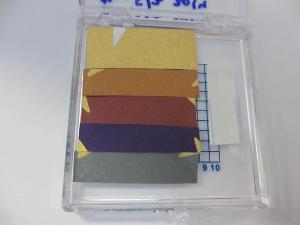Oct 1 2014
Harvard University researchers have explained a new method of applying ultra-thin coatings over a coarse surface based on the optical phenomena - thin-film interference. This work is considered to be a promising technology for future applications including next-generation spacecrafts with thin decorative logos, rocket ships, advanced solar cells, and flexible electronic devices. The work is published in Applied Physics Letters journal.
 These are gold-coated notebook paper pieces with ultra-thin germanium films of different thickness deposited on top. Credit: M. Kats / Harvard
These are gold-coated notebook paper pieces with ultra-thin germanium films of different thickness deposited on top. Credit: M. Kats / Harvard
Light passing through water containing oil exhibits different colors that tend to shift. This well-known phenomenon is known as thin-film interference applied in various optical devices. The Harvard team members, recently, described this behavior of light on flexible and rough surfaces.
Mikhail Kats, a Harvard University research scholar, stated that thin-film interference generally occurs in smooth substrates. He added that this behavior is likely to reduce with increasing roughness.
The researchers deposited a layer of gold followed by germanium on a paper. Owing to the angle of incidence of the thin film, the paper displayed interference. In general, interference colors are seen in transparent thin films which are not more than one-third of light wavelength i.e. 600nm. The formation of colors is due to changes in optical phases or optical path length with respect to the difference in viewer’s incidence angle.
The colors are visible to the observer along the path length such that the color changes slightly upon titling the observer’s head. However, at the nanoscale level, thin films undergo a decline in phase shift changes, which further causes a reduction in the effect of incidence angle. At this point, the color remains fixed upon tilting the head.
Kats said that this effect enables a user to view monolayers, bilayers or tri-layers of atoms with naked eye, enabling the metallic objects to be colored using material thinner than traditional paint. The orange, indigo, and violet shades can be viewed using the 7, 10 and 15nm layered paper sheets.
The thin films hold promise for developing future flexible photodetectors and optoelectronic devices such as solar cells.